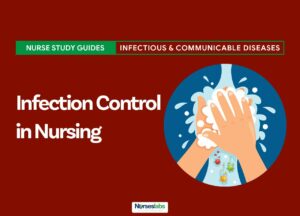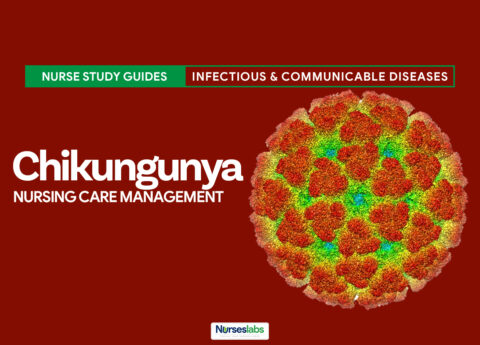Learn all the key facts about anthrax, including its causes, different types of anthrax, signs and symptoms, treatment, and nursing management in this study guide.
What is Anthrax?
Anthrax is an acute infectious disease caused by a spore-forming gram-positive, rod-shaped bacteria known as Bacillus anthracis. Anthrax is a rare and fatal zoonotic disease (animal to human transmission) that can be found naturally in soil and usually affects wild and domestic animals around the world.
- The term anthrakis means coal in Greek, and the disease is named after the black appearance of its cutaneous form.
- Contact with anthrax can cause severe illness in both humans and animals.
Pathophysiology
Anthrax is primarily a disease of herbivores (eg, cattle, sheep, goats, horses).
- Bacillus anthracis is a large, spore-forming, gram-positive rod.
- Persistence of spores is aided by nitrogen and organic soil content, environmental pH greater than 6, and ambient temperature greater than 15°C.
- Spores can exist indefinitely in the environment; optimal growth conditions result in a vegetative phase and bacterial multiplication.
- Drought or rainfall can trigger anthrax spore germination, while flies and vultures spread the spores.
- Anthrax toxins are composed of 3 entities: a protective antigen, a lethal factor, and an edema factor.
- The protective antigen is an 83-kd protein that binds to cell receptors within a target tissue.
- The binding of edema factor at this site results in the formation of edema toxin; the binding of lethal factor results in the formation of lethal toxin.
- Humans are relatively resistant to cutaneous invasion by B anthracis, but the organisms may gain access through microscopic or gross breaks in the skin.
- The organisms multiply locally and may spread to the bloodstream or other organs (eg, spleen) via the efferent lymphatics.
- Primary intestinal anthrax predominantly affects the cecum and produces a local lesion similar to the lesion produced in the cutaneous form.
- Inhaled spores are ingested by pulmonary macrophages and then carried to hilar and mediastinal lymph nodes.
- Anthrax in the lungs does not cause pneumonia, but it does cause hemorrhagic mediastinitis and pulmonary edema.
Causes
Anthrax is caused by Bacillus anthracis, a gram-positive bacillus.
- Working with infected animals or animal products. Most people who get sick from anthrax are exposed while working with infected animals or animal products such as wool, hides, or hair.
- Eating raw or undercooked meat from infected animals. People who eat raw or undercooked meat from infected animals may get infected with gastrointestinal anthrax; this usually occurs in countries where livestock are not routinely vaccinated against anthrax and food animals are not inspected prior to slaughter.
- Injecting heroin. A newly discovered type of anthrax is injection anthrax; this type of anthrax has been seen in northern Europe in people injecting heroin.
Types
The type of illness a person develops depends on how anthrax enters the body; typically, anthrax gets into the body through the skin, lungs, or gastrointestinal system.
- Cutaneous anthrax. Cutaneous anthrax is the most common form of anthrax infection, and it is also considered to be the least dangerous; cutaneous anthrax is most common on the head, neck, forearms, and hands; infection usually develops from 1 to 7 days after exposure.
- Inhalation anthrax. Inhalation anthrax is considered to be the most deadly form of anthrax; infection usually develops within a week after exposure, but it can take up to 2 months; without treatment, only about 10-15% of patients with inhalation anthrax survive.
- Gastrointestinal anthrax. Gastrointestinal anthrax has rarely been reported in the United States; infection usually develops from 1 to 7 days after exposure; once ingested, anthrax spores can affect the upper gastrointestinal tract, stomach, and intestines.
- Injection anthrax. Injection anthrax can spread throughout the body faster and be harder to recognize and treat; symptoms may be similar to those of cutaneous anthrax, but there may be infection deep under the skin or in the muscle where the drug was injected.
Statistics and Incidences
Natural incidence is rare, but infection is an occupational hazard among veterinarians, farmers, and individuals who handle animal wool, hair, hides, or bone meal products.
- From 1955–1994, US cases totaled 235, with 224 cases of cutaneous anthrax, 11 cases of inhalational anthrax, and 20 fatalities.
- In October 2001, 22 confirmed or suspected cases of anthrax infection were identified.
- Cases were reported from Florida, New York, New Jersey, the District of Columbia, and Connecticut.
- There were 11 confirmed cases of inhalational anthrax (5 deaths) and 7 confirmed and 4 suspected cases of cutaneous anthrax (no deaths).
- Anthrax is uncommon in Western Europe, but the disease is not uncommon in the Middle East, the Indian subcontinent, Africa, Asia, and Latin America.
- Anthrax is endemic in Africa and Asia despite vaccination programs.
Clinical Manifestations
The symptoms of anthrax depend on the type of infection and can take anywhere from 1 day to more than 2 months to appear.
- Cutaneous symptoms. A group of small blisters or bumps that may itch, swelling that occurs around the sore, and a painless skin sore or ulcer with a black center that appears after the small blisters or bumps.
- Inhalation symptoms. Inhalation anthrax symptoms can include fever and chills, chest discomfort, shortness of breath, confusion or dizziness, cough, nausea and vomiting or stomach pains, headache, sweats, extreme tiredness, and body aches.
- Gastrointestinal symptoms. Gastrointestinal symptoms include painful swallowing, hoarseness, nausea and bloody vomiting, diarrhea, stomach pain, and swelling of abdomen.
- Injection symptoms. Injection anthrax symptoms include fever and chills, a small group of blisters or bumps that may itch, appearing where the drug was injected, a painless skin sore with a black center, swelling around the sore, and abscesses deep under the skin or in the muscle where the drug was injected.
Assessment and Diagnostic Findings
Bacillus anthracis is present in high numbers in the ulcer/eschar of cutaneous anthrax, in bloody pleural fluid in inhalational anthrax, in the cerebrospinal fluid (CSF) in anthrax meningitis, and in the blood in septicemic anthrax.
- Gram stain and blood culture. The preferred diagnostic procedure for cutaneous anthrax is staining the ulcer exudate with methylene blue or Giemsa stain; B anthracis readily grows on blood agar, and staining microbiologically differentiates the organism from non–B anthracis bacilli.
- Enzyme-linked immunosorbent assay (ELISA). Enzyme-linked immunosorbent assay (ELISA) serologic diagnosis is also available; the ELISA for edema and lethal toxins is positive if a single acute-phase titer is highly elevated or if a fourfold greater rise in the titer is observed between acute and convalescent specimens.
- Chest radiography and computed tomography. If inhalational anthrax is suspected, obtain a chest radiograph or computed tomography (CT) scan; the appearance on chest radiograph or CT scan may suggest the diagnosis, especially if other predisposing disorders that might result in a widening mediastinum (eg, dissecting aortic aneurysm, bacterial mediastinitis) are absent.
- Lumbar puncture. If anthrax meningitis is suspected, perform a lumbar puncture to obtain CSF for stain and culture.
- Histologic findings. The characteristic finding in anthrax is the presence of the organisms in the capillaries at the infection site; therefore, if a patient is infected, expect B anthracis in the capillaries of the skin, intestines, liver, spleen, lungs, or leptomeninges.
Medical Management
There are several options to treat patients with anthrax; however, patients with serious cases may require aggressive treatment.
- Treatment for cutaneous anthrax. Patients with isolated cutaneous anthrax without systemic involvement (ie, without edema, fever, cough, headache, etc) or complications may be treated on an outpatient basis with antibiotic monotherapy.
- Prehospital care. Persons who are potentially contaminated should wash with soap and water, not bleach solutions; clothing and evidence/materials should be placed in plastic bags (triple); if the contamination is confirmed, then a 1:10 dilution of household beach may be used to decontaminate any materials and surfaces not sufficiently cleaned by soap and water.
- Emergency department care. The emergency department workup includes rapid initiation of intravenous antibiotic therapy; patients can be admitted to a normal hospital room with barrier nursing procedures (ie, gown, gloves, mask) and secretion precautions (ie, special handing of potentially infectious dressings, drainage, and excretions).
- Consultations. Anthrax is a reportable disease; notify local health care authorities and the Centers for Disease Control and Prevention of suspected cases; in addition, consultation with an infectious disease specialist may be warranted, although treatment of patients in whom anthrax is suspected is straightforward.
- Deterrence and prevention. For PEP in adults, the CDC recommends vaccination and the use of oral fluoroquinolones (ciprofloxacin, 500 mg bid; levofloxacin, 500 mg qd; or ofloxacin, 400 mg bid); a vaccine exists but is not readily available; preexposure vaccination is recommended only for populations at high risk of exposure to aerosolized B anthracis spores, according to the CDC’s Advisory Committee on Immunization Practices (ACIP).
Pharmacologic Management
Pharmacologic treatment of Anthrax include:
- Other antibiotics. Empirical antimicrobial therapy must be comprehensive and should cover all likely pathogens in the context of the clinical setting.
- Corticosteroids. These agents are used for severe edema, meningitis, or swelling in the head and neck region.
- Other antidotes. A monoclonal antibody (raxibacumab) and human anthrax immune globulin have been approved by the FDA using the animal efficacy rule for inhalational anthrax.
- Vaccines. The FDA approved a standard anthrax vaccine designated “anthrax vaccine adsorbed” (AVA), which is a sterile filtrate of cultures of an avirulent strain that elaborates protective antigen; no human controlled trials are available; it is the first vaccine approved utilizing the animal rule by the FDA; the efficacy of this vaccine in inhalation (biowarfare) anthrax is questionable.
Nursing Management
Nursing management for a patient with anthrax include the following:
Nursing Assessment
Nursing assessment for a patient with anthrax include:
- History. Anthrax is primarily zoonotic; no reports of direct human-to-human transmission exist in the literature, but laboratory personnel may contract the disease from specimens; military personnel and civilians may become exposed in biologic warfare situations; exposure may be through agriculture or industry.
- Physical assessment. Physical findings are nonspecific; the incubation period for all clinical manifestations is 1-6 days following exposure; the prodrome includes fever, malaise, and adenopathy.
Nursing Diagnosis
Based on the assessment data, the major nursing diagnosis for anthrax are:
- Ineffective airway clearance related to obstruction of the airway.
- Ineffective breathing pattern related to a decrease in lung expansion.
- Impaired swallowing related to mechanical obstruction (oropharyngeal edema).
- Diarrhea related to increased motility of the GI.
- Impaired tissue integrity related to irritant toxin anthrax bacteria.
- Hyperthermia related to an increase in metabolic demand.
Nursing Care Planning and Goals
The major nursing care planning goals for a patient with anthrax include:
- Improve patency of airway.
- Improve breathing pattern.
- Improve swallowing.
- Eliminate diarrhea.
- Improve tissue integrity.
- Improve temperature to normal range.
Nursing Interventions
The following are the nursing interventions for patients with anthrax:
- Improve airway patency. Auscultate chest for crackles, indicating the need for better secretion mobilization; monitor oxygen saturation and arterial blood gases periodically to determine oxygenation status and acid-base balance; and suction frequently and provide chest physiotherapy to clear airways, prevent atelectasis, and maximize oxygen therapy.
- Improve breathing pattern. Position for maximum chest expansion and reposition frequently to mobilize secretions; and provide supplemental oxygen or mechanical ventilation, as needed.
- Improve swallowing. Corticosteroids are used to decrease the swelling in the head or neck region.
- Eliminate diarrhea. Cases of gastrointestinal anthrax can be treated with ciprofloxacin or doxycycline for 60 days.
- Improve tissue integrity. Patients with isolated cutaneous anthrax without systemic involvement (ie, without edema, fever, cough, headache, etc) or complications may be treated on an outpatient basis with antibiotic monotherapy.
- Diminish hyperthermia. Administer analgesics as prescribed.
Evaluation
Nursing goals are met for a patient with anthrax as evidenced by:
- Improved patency of airway.
- Improved breathing pattern.
- Improved swallowing.
- Elimination of diarrhea.
- Improved tissue integrity.
- Improved temperature to normal range.
Documentation Guidelines
Documentation in a patient with anthrax include:
- Individual findings, including factors affecting, interactions, nature of social exchanges, specifics of individual behavior.
- Cultural and religious beliefs, and expectations.
- Plan of care.
- Teaching plan.
- Responses to interventions, teaching, and actions performed.
- Attainment or progress toward the desired outcome.
Summary
Here are some of the most important points about Anthrax:
- Anthrax is a serious infectious disease caused by gram-positive, rod-shaped bacteria known as Bacillus anthracis.
- There are four types of anthrax: cutaneous, inhalation, gastrointestinal, and injection anthrax.
- Anthrax is primarily a disease of herbivores (eg, cattle, sheep, goats, horses).
- Anthrax is NOT contagious.
- The type of illness a person develops depends on how anthrax enters the body; typically, anthrax gets into the body through the skin, lungs, or gastrointestinal system.
- Natural incidence is rare, but infection is an occupational hazard among veterinarians, farmers, and individuals who handle animal wool, hair, hides, or bone meal products.
- Natural incidence is rare, but infection is an occupational hazard among veterinarians, farmers, and individuals who handle animal wool, hair, hides, or bone meal products.
- Bacillus anthracis is present in high numbers in the ulcer/eschar of cutaneous anthrax, in bloody pleural fluid in inhalational anthrax, in the cerebrospinal fluid (CSF) in anthrax meningitis, and in the blood in septicemic anthrax.
- Patients with isolated cutaneous anthrax without systemic involvement (ie, without edema, fever, cough, headache, etc) or complications may be treated on an outpatient basis with antibiotic monotherapy.
- The emergency department workup includes rapid initiation of intravenous antibiotic therapy; patients can be admitted to a normal hospital room with barrier nursing procedures (ie, gown, gloves, mask) and secretion precautions (ie, special handing of potentially infectious dressings, drainage, and excretions).
References
Sources and references for this Anthrax study guide include:
• Centers for Disease Control and Prevention. (2017, Jan 31). Anthrax. Retrieved from https://www.cdc.gov/anthrax/
• Cennimo, D.J.(2018, Sept 13). Anthrax. Retrieved from https://emedicine.medscape.com/article/212127-overview





































Leave a Comment